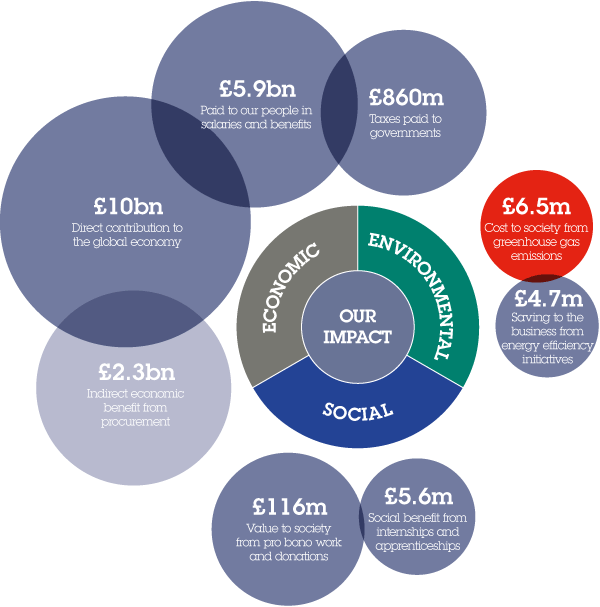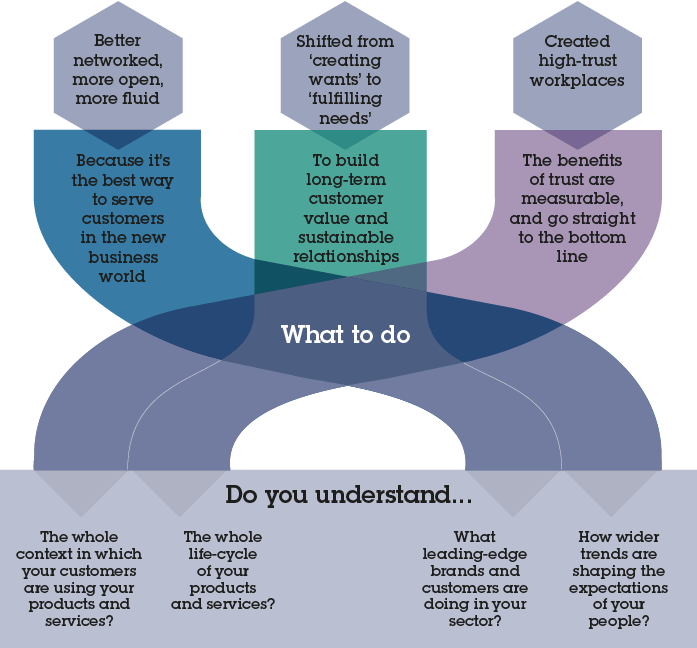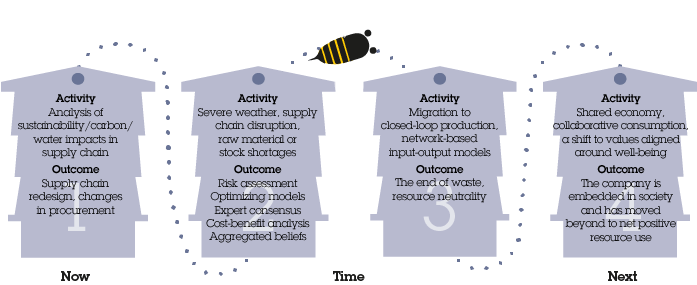Summary of our impact

- Positive impact
- Negative impact
- Indirect impact
We quantify the impacts of our business in terms of the financial cost or benefit to society. This enables us to compare the relative significance of different impacts and over time could help us to assess the value our business brings and where there are opportunities to enhance our contribution.
Our research this year shows a significant positive economic impact, both directly through our business activities, the salaries and benefits we pay to employees and our tax payments to governments and indirectly through the benefits resulting from our spend with suppliers. We also make a significant social contribution through the direct value of our pro bono work and charitable donations and indirectly through the impact of this support. Among the measures we have used, our main negative impact relates to the cost to society and future generations of greenhouse gas emissions associated with our business activities.
Economic impacts
We looked at the benefits associated with our economic activities including employee salaries, payments to suppliers, taxes to governments and dividends to share owners.
Our analysis shows a significant direct positive contribution to economies as well as a significant multiplier effect from the salaries and payments we make, which enable our people to buy goods and services and our suppliers to create jobs and spend in the economy.
Gross value added: £10 billion economic impact
The direct contribution our activities make to the worldwide economy is measured as Gross Value Added (GVA). This is calculated as the financial value of the services we sell minus the cost of all inputs directly related to delivery of these services. We estimate that the value of services we produce stands at more than £10 billion. This income is used to cover operating costs and taxes, and dividends.
Payroll: £5.9 billion in salaries and employee benefits
We are a major global employer, offering many thousands of well-remunerated positions. The almost £6 billion we spend on salaries and benefits provides a cash injection into local economies in the 111 countries in which we operate.
Taxes: £860 million paid to governments
Payments of taxes to national and local governments, including corporation and overseas taxes (£290 million) and social security taxes (£570 million), enables them to invest in local socioeconomic development.
Supply chain: £2.3 billion indirect economic benefit
Our companies provide indirect benefits to economies across the world through procurement of advertising production, research operations, facilities, human resources, IT, telecoms, travel and professional services. This spending provides many indirect benefits to the economy by supporting livelihoods and job creation. These calculations exclude our media spend on behalf of clients.
Clients: Not quantified
The communications services we provide create a further indirect benefit by helping our clients to increase their revenues, which stimulates growth and helps create jobs. We aim to explore ways of measuring this.
Social impacts
£91m
in wider benefits to society from pro bono work
Our companies support social and charitable activities through cash donations and by undertaking pro bono work (marketing advice and campaigns for little or no fee). This has an impact by helping charities to achieve campaign objectives, raise funds and recruit new members, and indirectly contributes to improving human health and community cohesion, and the protection of human rights and the environment. Our companies also provide internship and apprenticeship opportunities, which equip people with skills and experience that enhance their future life prospects.
Pro bono work: £91 million social benefit
The direct value of our pro bono work was £17.0 million in 2014, based on the fees that organisations would have paid for our work. Estimates suggest that this work created benefits to society worth around £91 million, for example, by helping to improve health and well-being in communities. We have not calculated the benefits of free media space negotiated on behalf of pro bono clients.
Charitable donations: £25 million social benefit
In 2014, WPP’s charitable donations were £4.8 million. These donations support important work in areas such as education, health, human rights, local community, environment and the arts. We estimate the value of the social benefits resulting from these donations to be around £25 million per year.
Internships and apprenticeships: £5.6 million social benefit
Currently we offer nearly 6,000 paid internship and apprenticeship positions across the Group. We estimate these create benefits worth £5.6 million annually, because some interns will be offered a position in a WPP company at the end of their internship and others are likely to find jobs elsewhere more quickly. Our support for education can be particularly important in helping to build the local skills base in countries like China, where the communications services sector is less well-established. See more information Internships and apprenticeships.
Environmental impacts
£4.7m
in avoided costs from improved energy efficiency
Climate change is our most significant environmental issue and we have a strategy and ambitious target to reduce our carbon emissions per employee. We have made significant progress; however, achieving an overall reduction is challenging as our business grows.
Greenhouse gas emissions: £6.5 million cost to society
Currently, businesses such as ours do not bear the environmental costs of mitigating their greenhouse gas (GHG) emissions. This service is provided for free by nature or at the cost of future generations. The hidden cost of our emissions is £6.5 million per year in 2014. This calculation takes into account our GHG emissions from energy, business air travel, and other estimated impacts such as leased cars, taxis and couriers as well as the benefits resulting from our green electricity purchasing and investment in renewable energy offsets, see below.
Energy consumption: £4.7 million in avoided utility costs
As our business has grown, our total energy consumption increased by 21% between 2006-2014. However, energy use per employee decreased by 22%, largely due to investments in energy efficiency. As a result, the Group avoided over £4.7 million in utility costs and avoided 72,000 tCO2e emissions.
Business air travel: 88 million air miles avoided
Since 2006, our total air miles increased by almost 35%, but air miles per employee fell by 14% and, as a result of our activities, we avoided over 88 million air miles and 31,000 tCO2e emissions. We invest in renewable energy carbon offsets to mitigate the impact of business air travel. In 2014, we offset 96,577 tCO2e and since 2007 we have offset over 1 million tCO2e.
Opinion
New sustainability, new values
Andrew Curry
The Futures Company
Over the last two decades, sustainability has moved from the edge of the business to its heart. There are multiple reasons, but the biggest is that the world has changed. Fundamental shifts in resources, technology and social values, are transforming the business landscape.
Some of these changes are more obvious that others. Every business has adapted, by now, to a world of ubiquitous personal digital technology and devices. Most have taken some steps to reduce energy and resource use and to improve the sustainability of their supply chains. The response to the third big shift, towards well-being (physical and psychological, individual and social) is less well-developed.
But the next stage in sustainability for business is about embracing all three legs of the famous Brundtland definition*: environmental, economic and social sustainability. It is this shift that underpins many critiques of market behaviours that were seen in the decades before the financial crisis, and which inform the critiques of markets and capitalism that have been written since.
As Michael Porter and Mark Kramer memorably observed in the Harvard Business Review, “The concept of shared value … recognizes that societal needs, not just conventional economic needs, define markets. It also recognizes that social harms or weaknesses frequently create internal costs for firms.”
In the UK, Geoff Mulgan, CEO of innovation charity, NESTA, argues in his book The Locust and the Bee that we are seeing a shift in the balance of market behaviour towards the creation of new or productive value (the bee) and away from the more extractive value (the locust) that dominated in the years leading up to the financial crisis.
This isn’t just a matter of businesses taking a different view of the world. When the external environment changes, business has to change too. The companies which respond first to the 21st century will gain competitive advantage by being better networked, more open, and more fluid. The reason: it is the best way to serve customers in the new business world.
But the structure and behaviour of many businesses is still shaped by the assumptions of the 20th century – about easy energy and resources, about ‘command and control’ management styles, and attitudes to the purpose of work. Nonetheless, in all sectors, the market leaders are already on a journey to make themselves less inward-looking and more responsive to their external environment.
Our report, The 21st Century Business, co-written with Jules Peck, outlines six significant shifts that will shape these competitive businesses:
- From disconnected to networked: Businesses are often internally disconnected silos separated by function. The networked business understands that its different parts form a single system, and acts on that.
- From closed to open: The closed business locks down ownership of knowledge. The open business is more porous, letting the outside world in and building mutual advantage.
- From fixed to fluid: 20th century planning and control models make businesses unresponsive and internally-focused. The fluid business uses management and budget processes that respond to external change.
- From volume to value: Mass production is giving way to businesses that tailor products and services to users. By wrapping products in a network of services they can provide more while using less.
- From risk to opportunity: Businesses will treat the external environment not as a series of threats but as a set of signs about the boundaries that society places on markets. Regulation becomes a platform for innovation and change.
- From consumers to citizens: Customers are more than consumers. Companies will succeed by understanding and delivering against needs that reflect their customers’ whole lives, as citizens as well as consumers.
The most important of these shifts is the last one, because it connects to the deep social change we are currently seeing towards well-being and ‘Post-Materialist’ values, originally proposed by Ronald Inglehart. Hardin Tibbs, who documented the links between these values and sustainability in a significant article in the Journal of Futures Studies, suggests that in the United States and in Europe we are at the transition point at which half of the population hold these post-materialist values, with the ‘Traditionalist’ and ‘Moderns’ groups slowly shrinking. People with these values, Tibbs notes, “like to think in terms of the whole system, … are concerned about future generations and the fate of the planet, and want to do business with responsible corporations.”
One of the ways we see this change is in a shift in social expression from ‘extrinsic’ or external values to ‘intrinsic’ or internal values. Although on the face of it, companies might think that extrinsically-oriented customers are more attractive – they are more interested in consumption and material display, after all – this would be a mistake.
As Jules Peck notes, an individual with strong extrinsic values “has a lower well-being than others, lowers the well-being of those around them, has a higher than average environmental footprint and is more closed than others to pro-social and environmental behaviour change messaging.” A business that has sustainability objectives involving any kind of behaviour change or sustainable response from customers will fail if its positioning and marketing is directed towards extrinsically-motivated customers.
Snapshot of the 21st century business
The 21st century business is being reshaped by a combination of resource pressures, shifting social values and ubiquitous technology. The businesses that win will have redesigned themselves.

The sustainability journey
A sustainability journey typically starts as a defensive response to a changing business context, stages 1 and 2 on the diagram. At stages 3 and 4 of the journey, we see disruptive innovation that reconfigures current business models and businesses reimagining their markets as being about delivering against real well-being needs rather than creating wants. Taken together, stages 3 and 4 on the matrix represent the 21st century business.

The ‘intrinsic business’ that is talking to customers as citizens, not consumers, is thinking about the whole of its customers’ lives, not just the path to purchase
The same is true of employees. Extrinsically-motivated employees are motivated almost entirely by the deal: salary, bonuses, benefits. They have little loyalty and low levels of commitment. Intrinsically-motivated employees are more likely to respond to the purpose of the work and engage with the business on an emotional level. Since employee engagement is one of the main drivers of performance and profitability, the benefits of being an intrinsically positioned business go straight to the bottom line.
So, the ‘intrinsic business’ that is talking to customers as citizens, not consumers, is thinking about the whole of its customers’ lives, not just the path to purchase. These customers, in turn, expect businesses to help them solve problems rather than simply to sell them something.
With Unilever, for example, one of the goals of Project Sunlight is to build a world “where every home has enough water to drink and to wash, cook and clean.” This means thinking through the impact of personal care products, and others, in the everyday lives of its customers, many of whom live in increasingly water-stressed areas.
The same principles apply in richer parts of the world and in sectors where engagement is regarded as a tougher proposition. In Spain, the supermarket Mercadona has prospered by paying its staff higher wages and training them extensively, while focusing on understanding the needs of its customers. In contrast, others that have concentrated largely on price and logistics have floundered since the financial crisis.
What all of these examples have in common is that sustainability – in its widest sense – has moved out of the corporate affairs department and has become a source of strategic differentiation. Sustainability is rapidly becoming part of business as usual. More importantly, it’s becoming an essential part of competitive advantage.